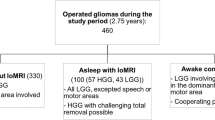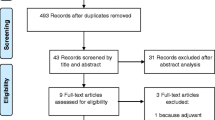Abstract
Several methods have been introduced to improve the extent of resection in glioma surgery. Yet, radical tumor resections must not be attempted at the cost of neurological deterioration. We sought to assess whether the use of an intraoperative MRI (iMRI) in combination with multimodal neurophysiological monitoring is suitable to increase the extent of resection without endangering neurological function in patients with eloquently located gliomas. Fifty-four patients were included in this study. In 21 patients (38.9 %), iMRI led to additional tumor resection. A radiologically complete resection was achieved in 31 patients (57.4 %), while in 12 of these, iMRI had depicted residual tumor tissue before resection was continued. The mean extent of resection was 92.1 % according to volumetric analyses. Postoperatively, 13 patients (24.1 %) showed new or worsening of pre-existing sensory motor deficits. They were severe in 4 patients (7.4 %). There was no correlation between the occurrence of either any new (P = 0.77) or severe (P = 1.0) sensory motor deficit and continued resection after intraoperative image acquisition. Likewise, tumor location, histology, and tumor recurrence did not influence complication rate on uni- and multivariate analysis. We conclude that the combination of iMRI guidance with multimodal neurophysiological monitoring allows for extended resections in glioma surgery without inducing higher rates of neurological deficits, even in patients with eloquently located tumors.


Similar content being viewed by others
References
Claus EB, Horlacher A, Hsu L, Schwartz RB, Dello-Iacono D, Talos F, Jolesz FA, Black PM (2005) Survival rates in patients with low-grade glioma after intraoperative magnetic resonance image guidance. Cancer 103(6):1227–1233. doi:10.1002/cncr.20867
McGirt MJ, Chaichana KL, Gathinji M, Attenello FJ, Than K, Olivi A, Weingart JD, Brem H, Quinones-Hinojosa A (2009) Independent association of extent of resection with survival in patients with malignant brain astrocytoma. J Neurosurg 110:156–162. doi:10.3171/2008.4.17536
Sanai N, Berger MS (2008) Glioma extent of resection and its impact on patient outcome. Neurosurgery 62:753–764 (discussion 764–756). doi:10.1227/01.neu.0000318159.21731.cf
Stummer W, Reulen HJ, Meinel T, Pichlmeier U, Schumacher W, Tonn JC, Rohde V, Oppel F, Turowski B, Woiciechowsky C, Franz K, Pietsch T (2008) Extent of resection and survival in glioblastoma multiforme: identification of and adjustment for bias. Neurosurgery 62:564–576 (discussion 564–576). doi:10.1227/01.neu.0000317304.31579.17
Smith JS, Chang EF, Lamborn KR, Chang SM, Prados MD, Cha S, Tihan T, Vandenberg S, McDermott MW, Berger MS (2008) Role of extent of resection in the long-term outcome of low-grade hemispheric gliomas. J Clin Oncol 26:1338–1345. doi:10.1200/JCO.2007.13.9337
Black PM, Alexander E III, Martin C, Moriarty T, Nabavi A, Wong TZ, Schwartz RB, Jolesz F (1999) Craniotomy for tumor treatment in an intraoperative magnetic resonance imaging unit. Neurosurgery 45:423–431 (discussion 431–423)
Nimsky C, Fujita A, Ganslandt O, Von Keller B, Fahlbusch R (2004) Volumetric assessment of glioma removal by intraoperative high-field magnetic resonance imaging. Neurosurgery 55:358–370 (discussion 370–351)
Hall WA, Liu H, Martin AJ, Pozza CH, Maxwell RE, Truwit CL (2000) Safety, efficacy, and functionality of high-field strength interventional magnetic resonance imaging for neurosurgery. Neurosurgery 46:632–641 (discussion 641–632)
Seifert V, Zimmermann M, Trantakis C, Vitzthum HE, Kuhnel K, Raabe A, Bootz F, Schneider JP, Schmidt F, Dietrich J (1999) Open MRI-guided neurosurgery. Acta Neurochir (Wien) 141:455–464
Senft C, Seifert V, Hermann E, Franz K, Gasser T (2008) Usefulness of intraoperative ultralow-field magnetic resonance imaging in glioma surgery. Neurosurgery 63 (Suppl 2):257–266 (discussion 266–257). doi:10.1227/01.NEU.0000313624.77452.3C
Schneider JP, Trantakis C, Rubach M, Schulz T, Dietrich J, Winkler D, Renner C, Schober R, Geiger K, Brosteanu O, Zimmer C, Kahn T (2005) Intraoperative MRI to guide the resection of primary supratentorial glioblastoma multiforme—a quantitative radiological analysis. Neuroradiology 47:489–500. doi:10.1007/s00234-005-1397-1
Wirtz CR, Knauth M, Staubert A, Bonsanto MM, Sartor K, Kunze S, Tronnier VM (2000) Clinical evaluation and follow-up results for intraoperative magnetic resonance imaging in neurosurgery. Neurosurgery 46:1112–1120 (discussion 1120–1112)
Senft C, Franz K, Ulrich CT, Bink A, Szelenyi A, Gasser T, Seifert V (2010) Low field intraoperative MRI-guided surgery of gliomas: a single center experience. Clin Neurol Neurosurg 112:237–243. doi:10.1016/j.clineuro.2009.12.003
Senft C, Bink A, Franz K, Vatter H, Gasser T, Seifert V (2011) Intraoperative MRI guidance and extent of resection in glioma surgery: a randomised, controlled trial. Lancet Oncol 12:997–1003. doi:10.1016/S1470-2045(11)70196-6
Simon M, Schramm J (2009) Surgical management of intracranial gliomas. Recent Results Cancer Res 171:105–124. doi:10.1007/978-3-540-31206-2_6
Iwamoto FM, Cooper AR, Reiner AS, Nayak L, Abrey LE (2009) Glioblastoma in the elderly: the Memorial Sloan-Kettering Cancer Center Experience (1997–2007). Cancer 115:3758–3766. doi:10.1002/cncr.24413
Duffau H (2007) Contribution of cortical and subcortical electrostimulation in brain glioma surgery: methodological and functional considerations. Neurophysiol Clin 37:373–382. doi:10.1016/j.neucli.2007.09.003
Sala F, Lanteri P (2003) Brain surgery in motor areas: the invaluable assistance of intraoperative neurophysiological monitoring. J Neurosurg Sci 47:79–88
Szelenyi A, Langer D, Kothbauer K, De Camargo AB, Flamm ES, Deletis V (2006) Monitoring of muscle motor evoked potentials during cerebral aneurysm surgery: intraoperative changes and postoperative outcome. J Neurosurg 105:675–681. doi:10.3171/jns.2006.105.5.675
Szelenyi A, Senft C, Jardan M, Forster MT, Franz K, Seifert V, Vatter H (2011) Intra-operative subcortical electrical stimulation: a comparison of two methods. Clin Neurophysiol 122:1470–1475. doi:10.1016/j.clinph.2010.12.055
Szelenyi A, Gasser T, Seifert V (2008) Intraoperative neurophysiological monitoring in an open low-field magnetic resonance imaging system: clinical experience and technical considerations. Neurosurgery 63 (Suppl 2):268–275 (discussion 275–266). doi:10.1227/01.NEU.0000310705.72487.F9
Hadani M, Spiegelman R, Feldman Z, Berkenstadt H, Ram Z (2001) Novel, compact, intraoperative magnetic resonance imaging-guided system for conventional neurosurgical operating rooms. Neurosurgery 48:799–807 (discussion 807–799)
Schulder M, Salas S, Brimacombe M, Fine P, Catrambone J, Maniker AH, Carmel PW (2006) Cranial surgery with an expanded compact intraoperative magnetic resonance imager. Technical note. J Neurosurg 104:611–617. doi:10.3171/jns.2006.104.4.611
Stummer W, Tonn JC, Mehdorn HM, Nestler U, Franz K, Goetz C, Bink A, Pichlmeier U (2011) Counterbalancing risks and gains from extended resections in malignant glioma surgery: a supplemental analysis from the randomized 5-aminolevulinic acid glioma resection study. Clinical article. J Neurosurg 114:613–623. doi:10.3171/2010.3.JNS097
Talacchi A, Turazzi S, Locatelli F, Sala F, Beltramello A, Alessandrini F, Manganotti P, Lanteri P, Gambin R, Ganau M, Tramontano V, Santini B, Gerosa M (2010) Surgical treatment of high-grade gliomas in motor areas. The impact of different supportive technologies: a 171-patient series. J Neurooncol 100:417–426. doi:10.1007/s11060-010-0193-x
Neuloh G, Simon M, Schramm J (2007) Stroke prevention during surgery for deep-seated gliomas. Neurophysiol Clin 37:383–389. doi:10.1016/j.neucli.2007.09.002
Muragaki Y, Iseki H, Maruyama T, Kawamata T, Yamane F, Nakamura R, Kubo O, Takakura K, Hori T (2006) Usefulness of intraoperative magnetic resonance imaging for glioma surgery. Acta Neurochir Suppl 98:67–75
Simon M, Neuloh G, von Lehe M, Meyer B, Schramm J (2009) Insular gliomas: the case for surgical management. J Neurosurg 110:685–695. doi:10.3171/2008.7.JNS17639
Brell M, Ibanez J, Caral L, Ferrer E (2000) Factors influencing surgical complications of intra-axial brain tumours. Acta Neurochir (Wien) 142:739–750
Keles GE, Lundin DA, Lamborn KR, Chang EF, Ojemann G, Berger MS (2004) Intraoperative subcortical stimulation mapping for hemispherical perirolandic gliomas located within or adjacent to the descending motor pathways: evaluation of morbidity and assessment of functional outcome in 294 patients. J Neurosurg 100:369–375. doi:10.3171/jns.2004.100.3.0369
Gil-Robles S, Duffau H (2010) Surgical management of World Health Organization Grade II gliomas in eloquent areas: the necessity of preserving a margin around functional structures. Neurosurg Focus 28:E8. doi:10.3171/2009.12.FOCUS09236
Kral T, Kurthen M, Schramm J, Urbach H, Meyer B (2006) Stimulation mapping via implanted grid electrodes prior to surgery for gliomas in highly eloquent cortex. Neurosurgery 58(Suppl):36–43
Goebel S, Nabavi A, Schubert S, Mehdorn HM (2010) Patient perception of combined awake brain tumor surgery and intraoperative 1.5-T magnetic resonance imaging: the Kiel experience. Neurosurgery 67:594–600 (discussion 600). doi:10.1227/01.NEU.0000374870.46963.BB
Leuthardt EC, Lim CC, Shah MN, Evans JA, Rich KM, Dacey RG, Tempelhoff R, Chicoine MR (2011) Use of movable high-field-strength intraoperative magnetic resonance imaging with awake craniotomies for resection of gliomas: preliminary experience. Neurosurgery 69:194–206. doi:10.1227/NEU.0b013e31821d0e4c
Kim SS, McCutcheon IE, Suki D, Weinberg JS, Sawaya R, Lang FF, Ferson D, Heimberger AB, DeMonte F, Prabhu SS (2009) Awake craniotomy for brain tumors near eloquent cortex: correlation of intraoperative cortical mapping with neurological outcomes in 309 consecutive patients. Neurosurgery 64:836–845 (discussion 345–836). doi:10.1227/01.NEU.0000342405.80881.81
Berger MS, Kincaid J, Ojemann GA, Lettich E (1989) Brain mapping techniques to maximize resection, safety, and seizure control in children with brain tumors. Neurosurgery 25:786–792
Burke D, Hicks RG (1998) Surgical monitoring of motor pathways. J Clin Neurophysiol 15:194–205
Duffau H, Lopes M, Arthuis F, Bitar A, Sichez JP, Van Effenterre R, Capelle L (2005) Contribution of intraoperative electrical stimulations in surgery of low grade gliomas: a comparative study between two series without (1985–96) and with (1996–2003) functional mapping in the same institution. J Neurol Neurosurg Psychiatry 76:845–851. doi:10.1136/jnnp.2004.048520
Gupta DK, Chandra PS, Ojha BK, Sharma BS, Mahapatra AK, Mehta VS (2007) Awake craniotomy versus surgery under general anesthesia for resection of intrinsic lesions of eloquent cortex–a prospective randomised study. Clin Neurol Neurosurg 109:335–343. doi:10.1016/j.clineuro.2007.01.008
Kuhnt D, Bauer MH, Becker A, Merhof D, Zolal A, Richter M, Grummich P, Ganslandt O, Buchfelder M, Nimsky C (2011) Intraoperative visualization of fiber tracking based reconstruction of language pathways in glioma surgery. Neurosurgery. doi:10.1227/NEU.0b013e318237a807
Romano A, D’Andrea G, Calabria LF, Coppola V, Espagnet CR, Pierallini A, Ferrante L, Fantozzi L, Bozzao A (2011) Pre- and intraoperative tractographic evaluation of corticospinal tract shift. Neurosurgery 69:696–704 (discussion 704–695). doi:10.1227/NEU.0b013e31821a8555
Gulati S, Berntsen EM, Solheim O, Kvistad KA, Haberg A, Selbekk T, Torp SH, Unsgaard G (2009) Surgical resection of high-grade gliomas in eloquent regions guided by blood oxygenation level dependent functional magnetic resonance imaging, diffusion tensor tractography, and intraoperative navigated 3D ultrasound. Minim Invasive Neurosurg 52:17–24. doi:10.1055/s-0028-1104566
Chang SM, Parney IF, McDermott M, Barker FG II, Schmidt MH, Huang W, Laws ER Jr, Lillehei KO, Bernstein M, Brem H, Sloan AE, Berger M (2003) Perioperative complications and neurological outcomes of first and second craniotomies among patients enrolled in the Glioma Outcome Project. J Neurosurg 98:1175–1181. doi:10.3171/jns.2003.98.6.1175
Dützmann S, Gessler F, Bink A, Quick J, Franz K, Seifert V, Senft C (2012) Risk of ischemia in glioma surgery: comparison of first and repeat procedures. J Neurooncol. 107(3):599–607. doi:10.1007/s11060-011-0784-1
Nimsky C, Ganslandt O, Buchfelder M, Fahlbusch R (2003) Glioma surgery evaluated by intraoperative low-field magnetic resonance imaging. Acta Neurochir Suppl 85:55–63
Senft C, Franz K, Blasel S, Oszvald A, Rathert J, Seifert V, Gasser T (2010) Influence of iMRI-guidance on the extent of resection and survival of patients with glioblastoma multiforme. Technol Cancer Res Treat 9:339–346
Hall WA, Liu H, Maxwell RE, Truwit CL (2003) Influence of 1.5-Tesla intraoperative MR imaging on surgical decision making. Acta Neurochir Suppl 85:29–37
Acknowledgment
The authors would like to thank H. Ackermann for help with statistics.
Disclosure
CS has received honoraria as a speaker from Medtronic. AS has received honoraria as a speaker from Inomed. There has been no financial support of this study by the companies.
Conflict of interest
All other authors declare that they have no potential conflicts of interest.
Author information
Authors and Affiliations
Corresponding author
Rights and permissions
About this article
Cite this article
Senft, C., Forster, MT., Bink, A. et al. Optimizing the extent of resection in eloquently located gliomas by combining intraoperative MRI guidance with intraoperative neurophysiological monitoring. J Neurooncol 109, 81–90 (2012). https://doi.org/10.1007/s11060-012-0864-x
Received:
Accepted:
Published:
Issue Date:
DOI: https://doi.org/10.1007/s11060-012-0864-x




